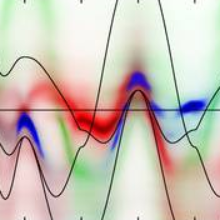As several (at the very least two) orbitals contribute weight to states near the Fermi level of iron-based superconductors, the question of orbital physics naturally arises [1]. Recently, we looked at one particular issue, namely the rotational symmetry breaking associated with a structural phase transition, which occurs at temperatures slightly above the onset of a spin-density wave in several compounds [2]. It could be due to the lattice distortion, but the differences in bond lengths seem too small to explain a spectral density A(k, ω) whose broad features look closer to the spin-density wave than to the symmetric high-temperature state. Spontaneous orbital order could explain this [3], however, tendencies to orbital polarization in the spin-density wave itself are very weak [4]. Another possible explanation is based on breaking the rotational symmetry through spin fluctuations, which select ordering vector (π,0) over the equivalent (0,π) without establishing long-range magnetic order right way [5]. A(k, ω) can readily be calculated in the first case, at least on a mean-filed level, but the same straight-forward approach does not work in the spin-nematic scenario: we need short-range spin correlations to break rotational symmetry, but mean-field would then immediately stabilize long-range order. We worked around this issue by coupling small real-space clusters (where short-range correlations break rotational symmetry) in momentum space (without long-range magnetic order) in cluster-perturbation theory. This allows us to establish that a spin-nematic state agrees better with experiment than brute-force orbital order [6]. Results become a bit more complicated once onsite Coulomb correlations are included, as orbital and nematic order then lead to more similar predictions for A(k, ω). However, we found that correlations do not make it easier to induce orbital order, making spontaneous orbital order a less likely scenario [7]. Moreover, total orbital polarization is not a good predictor of features near the Fermi surface, as states with and without orbital order may differ mostly in spectral weight at higher excitation energies [6]. Orbital character of low-energy states and total orbital occupation numbers, orbital polatization as in the orbital-order scenario, can thus be quite different. Finally, we also found that pure lattice distortions cannot give the experimentally observed A(k, ω), with or without onsite Coulomb correlations [7].
[1] F. Krueger, S. Kumar, J. Zaanen, J. van den Brink, Phys. Rev. B 79, 054504 (2009).
[2] M Yi et al., PNAS 108, 12238 (2011); M Yi et al., New J. Phys. 14, 073019 (2012); C. He et al., Phys. Rev. Lett. 105, 11702 (2010); Y Zhang et al., Phys. Rev. B 85, 085121 (2012).
[3] W. Lv and P. Phillips, Phys. Rev. B 84, 174512 (2011).
[4] M. Daghofer, A. Nicholson, A. Moreo, E. Dagotto, Phys. Rev. B 81, 014511 (2010); M. Daghofer et al., Phys. Rev. B 81, 180514 (2010); B. Valenzuela, E. Bascones, and M. Calderon, Phys. Rev. Lett. 105, 207202 (2010).
[5] R. M. Fernandes, A. V. Chubukov, J. Knolle, I. Eremin, J. Schmalian, Phys. Rev. B 85, 024534 (2012).
[6] M. Daghofer, A. Nicholson, A. Moreo, Phys. Rev. B 85, 184515 (2012).
[7] M. Daghofer and A. Fischer, Supercond. Sci. Technol. 25, 084003 (2012).
Contact

Sebastian Loth
Prof. Dr.Head of Institute FMQ1 (managing director)



